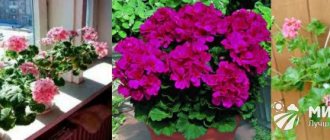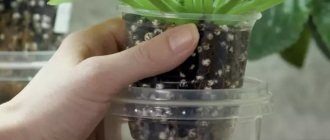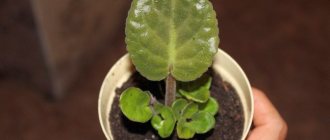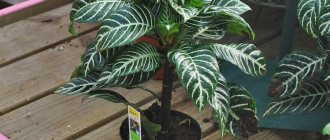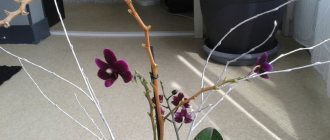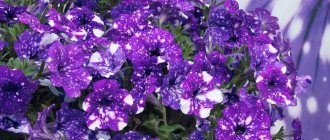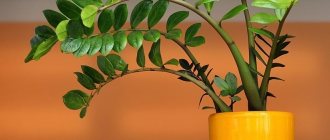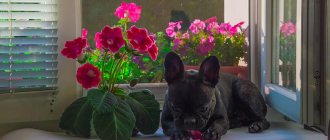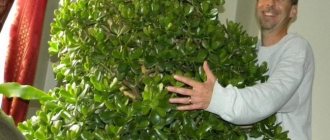Caring for scindapsus
Almost all types of scindapsus do not require complex care; even novice indoor plant lovers can grow them. But if you want to get highly decorative specimens that will become a real decoration of the interior, you need to follow the basic rules for caring for scindapsus at home , which this section is devoted to.
Lighting
In the natural conditions of tropical forests, these vines practically do not see direct sunlight, being in the shade of tree crowns. Consequently, they do not like too bright light; the intense summer sun causes their succulent foliage to fade and turn pale, and burn spots may appear on it. However, the lack of lighting also reduces their decorative value - in variegated varieties the brightness of color disappears, the internodes and petioles become elongated.
The best option would be to place flowerpots on the window sills of northern windows or near windows of eastern or western orientation, where they will be illuminated by diffused light and the dim rays of the rising or setting sun. In southern rooms they should be hidden in the shade, especially during the summer months. Scindapsus also grow well under artificial light.
Temperature
All types of scindapsus are heat-loving; they cannot tolerate temperatures below +15°C. They should not be exposed to cold drafts or sudden temperature changes. In the cold season, you need to make sure that the flowerpots do not stand on cold floors and window sills; you need to place sheets of foam plastic or other insulation under them. Overcooling of the roots can lead to their rotting and death of the plant.
These tropical vines tolerate heat well if you don’t forget to water them on time. At temperatures from +30°C and above, water and spray the scindapsus more often, and they will thank you with their brightness and lush growth.
Humidity
These inhabitants of the tropics are accustomed to high air humidity, but they also thrive in the dry air of apartments. It is only important to ensure that the plants are not exposed to hot air from heating radiators; even the hardiest plants will not withstand such a test.
Watering should be moderate as the top layer of the substrate dries. You need to take settled water, without chlorine, its temperature should be 2-3 degrees above room temperature.
In conditions of low temperatures and short daylight hours, watering should be reduced, because during this period the plant consumes less water, and its excess in the pot can lead to rotting of the roots. Scindapsus love being sprayed and washed in the shower. After water treatments they look especially impressive. When spraying, use soft water so that there are no indelible salt stains left on the leaves.
Substrate composition and pots
Scindapsus are not picky about the composition of the soil; they are also grown hydroponically. To grow them at home, you can take any substrate - leaf or garden soil with baking powder, peat or coconut substrate. Any plastic or ceramic pots will do, as long as there are drainage holes at the bottom and the volume is not too large. The volume of soil per cutting should be about 200 ml. To obtain lush specimens, 5-10 cuttings are planted in one pot, and the volume of the pot is selected in accordance with this quantity.
Fertilizer
Scindapsus quickly gain leaf mass, so they require regular feeding. Fertilizers for them can be taken organic or mineral, in which nitrogen predominates. You can buy any fertilizer for decorative foliage plants. For variegated specimens, the recommended dosage should be halved.
During the active growing season (March-October), fertilizing is done twice a month, the rest of the time - monthly. If kept warm and provided with additional lighting in winter, the frequency of fertilization does not need to be changed. Plants also respond well to the method of fertilizing with each watering, when a quarter of the recommended dose of fertilizer is added to the irrigation water. This method should not be used only at low temperatures and short daylight hours. You can also add long-acting fertilizers for decorative foliage plants to the soil.
Reproduction
It is best to propagate scindapsus in spring or summer, but at normal room temperature and the presence of artificial lighting, this can be done at any time of the year. For propagation, the stem is cut into sections with two internodes. The resulting cuttings can be rooted in water or peat substrate. When rooting in the ground, it is better to place a glass with cuttings in a greenhouse from a transparent bag and place it closer to the light. The rudiments of aerial roots are located throughout the stem of these vines, so they take root easily.
To obtain decorative specimens, several cuttings are planted in a pot. If there is only one cutting, it is grown into one stem, and then the cuttings are taken and the resulting plants are planted together, producing lush bushes. Another method for producing many shoots is to staple the growing stem in several places to the ground, spreading it in a spiral in the pot. In places of contact with the substrate, the plant will take root, and young shoots will emerge from each leaf.
Transfer
It is recommended to replant young scindapsus once every six months, and it is advisable to replant adult specimens every spring. When replanting, the diameter of the pot should be 4-5 cm larger than the old one. If the plant loses its decorative appearance or exposes its stems, it is better to rejuvenate it by cutting young shoots.
While the plant is small, it can be grown as an ampel plant, but in general, like all vines, scindapsus prefer to climb along supports. To do this, you can stick a special lattice or stick wrapped in coconut fiber into the pot. You can also string ropes along which the stems will curl, creating a special coziness and exotic atmosphere in the apartment.
Types of scindapsus with photos
At home, both natural species of scindapsus and varieties obtained as a result of selection are grown, which are distinguished by their varied colors and highly decorative leaves. Let's look at the most common types of scindapsus with photos and names .
Golden scindapsus (Epipremnum aureum)
This natural type of scindapsus is the most common in indoor floriculture. It is loved for its unpretentiousness, good growth in low light conditions and the beauty of its variegated leaves. The bright green leaf blades, up to 10 cm long, are heart-shaped, have a glossy sheen and yellow strokes, from which the plant gets its name. Densely leafy, unbranched shoots entwine the supports, and in their absence hang down in a beautiful cascade.
Golden scindapsus (Epipremnum aureum)
In America it is called Golden Pothos. But it turns golden only when there is sufficient lighting; in too shaded places the leaves lose their variegated color and become green. Some believe that there is a species of scindapsus with purely green leaves, but these are simply specimens that have lost their “gold” due to inappropriate conditions and improper care of scindapsus goldenus at home .
Scindapsus Marble Queen (Epipremnum Marble Queen)
“Marble Queen” is how the name of this variety is translated. Its creamy leaves, painted with dark green strokes, truly resemble marble in appearance. Thanks to its unusual coloring and densely leafy shoots, the Marble Queen variety has high decorative qualities. It is especially beautiful in combination with the greenery of other plants. But with a lack of light, its main advantage - marble color - may disappear.
Scindapsus Marble Queen (Epipremnum Marble Queen)
Scindapsus Neon (Epipremnum Neon)
The bright green leaves of this vine resemble the lights of neon signs, which is how the variety got its name. The brightness of the color depends on the lighting; most of the “neon” will be on the leaves of plants located near the eastern and western windows, and in shaded places the shoots turn pale. Scindapsus Neon is especially beautiful in “company” with the golden variety.
Scindapsus Neon (Epipremnum Neon)
Scindapsus Joy (Epipremnum N' Joy)
A distinctive feature of this variety are small leaves decorated with large white spots. Unlike other scindapsus, the surface of the leaf blade is not smooth and has irregularities. This contrasting variety pairs well with the green foliage of other plants. However, it is not recommended to plant it in the same pot with other types of scindapsus, since Enjoy grows slowly and fast-growing vines will inhibit it.
Scindapsus Joy (Epipremnum N' Joy)
Scindapsus Pictus
All vines classified by botanists as belonging to the genus Scindapsus (as opposed to epipremnums) have matte dark green leaves with a bluish tint, decorated with silver spots. Different species differ in leaf size and different patterns of silvery spots. They can be small and scattered, or merge and almost completely cover the surface of the leaf.
Scindapsus painted
Scindapsus Painted or Pictus has small leaf plates - 7-8 cm, with a silvery border along the edge. Small silvery specks are scattered throughout the leaf. This species is a slow growing species.
Scindapsus Siamese (Scindapsus Siamensis)
Scindapsus siamese has an average leaf size of 12 cm. The matte bluish-green leaf plate is not symmetrical; the central vein divides it into unequal parts. On both sides of it there are silvery spots that merge with each other. Like the painted one, this species is also characterized by slow growth.
Scindapsus Siamese (Scindapsus Siamensis)
Scindapsus Trebie
This is a variety of Siamese scindapsus, distinguished by the location of its spots. They do not merge together, but simply condense on both sides of the central vein.
Scindapsus Trebie
Scindapsus Exotica
This variety has large (up to 12 cm) leaves, almost completely covered with a silvery coating. Only along the central vein and the edges of the leaf blade does a bluish-green background appear in narrow stripes. Scindapsus Exotica is valued for its spectacular, shiny, metallic leaves. This variety is more finicky in care than natural species.
Scindapsus Exotica
